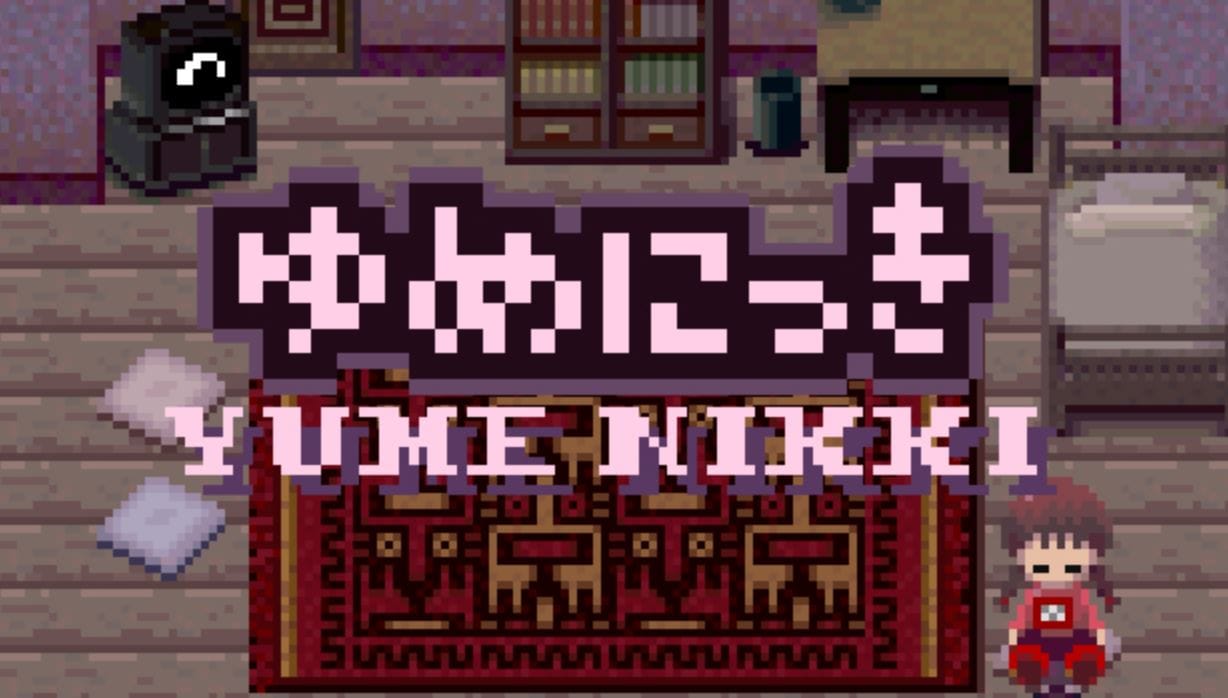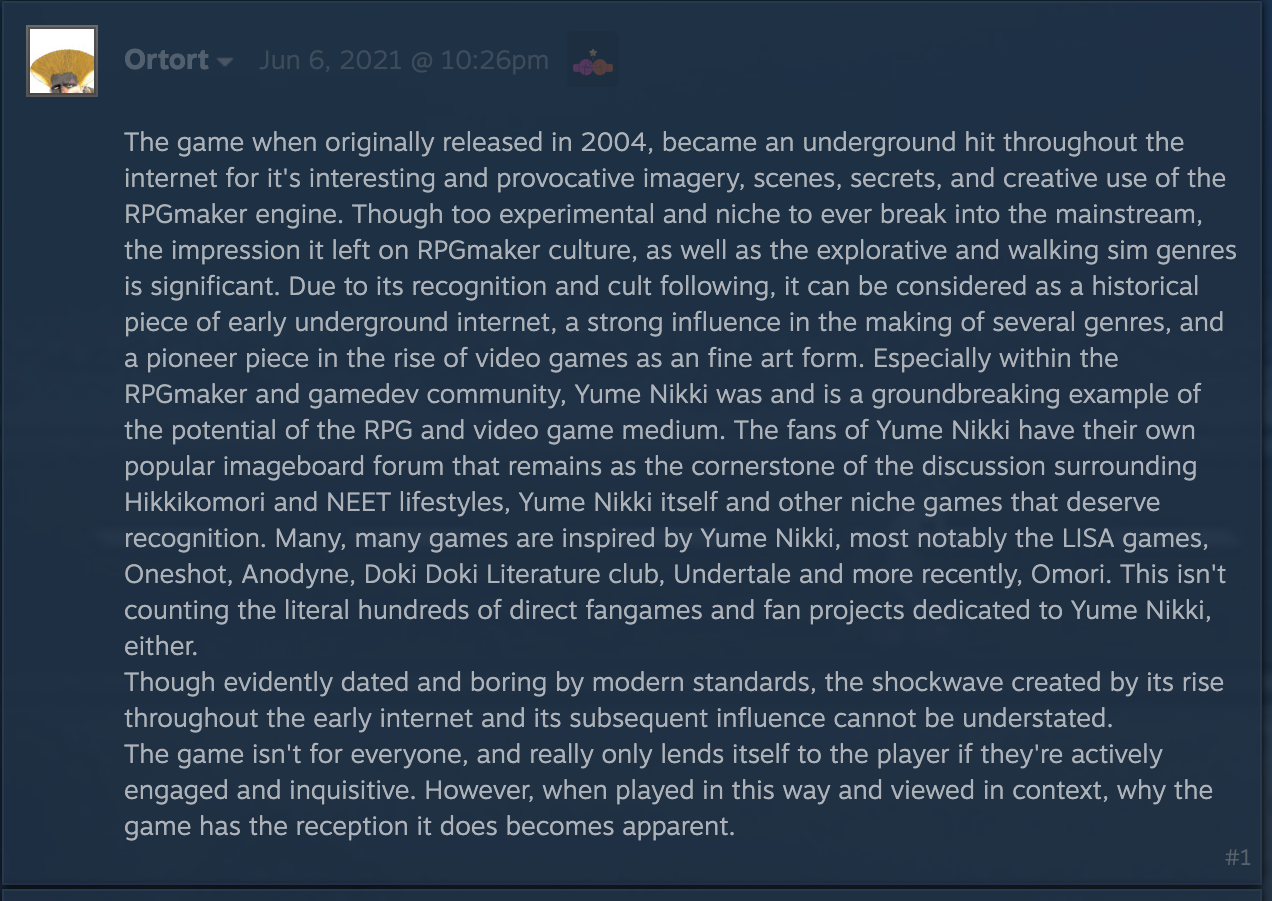20 Years of Yume Nikki
The danger of dreams in RPG-form

Yume Nikki came out in 2004. It seemed to be a little RPG about a girl who can't go outside and only finds solace through the dream world. Yet even her dreamworld doesn't provide any reassurance, as she walks or rides through colorful nightmares past trippy characters. She can use a knife to take down NPCs, but meddling with dreams may have consequences. Random events may spawn, hinting at why Madotsuki has become a hikikomori– a Japanese term for "recluse–who hides away from the real world. If you wish to dive into them, there are many videos that go through the worlds, items, and events that you can trigger.
Twenty years later, Yume Nikki continues to compel questions with few answers. Kikiyama, the developer, tends to keep out of the public and gave short responses during an interview with Toby Fox. The original freeware game has since spawned a 2018 reboot subtitled Dream Diary, a manga, and a light novel. Yet, when discussing their interpretations of the trippy visuals, players disagree on what it all means and what these dreams signify about Madotsuki's past. Others wonder if the game's strength lies in its ambiguity.
A different time
One user on Steam, Ortort, explained why Yume Nikki was very formative. RPGMaker (the software suite used to make the game) was relatively new, and so were Internet communities centered around games and video game development.

In 2004, social media didn't exist as we know it. YouTube and Twitch hadn't reached prominence for Let's Play videos, streaming, or analyses. A game would have to rely on word-of-mouth, promotion in magazines or email lists, or independent websites providing reviews, so the fact that Yume Nikki gained a following was remarkable.
We also didn't have content warnings then. Yume Nikki is quite upfront that it's a game depicting death onscreen, whether in the real world or the dream world. One game that pays homage to it, Omori, made sure to include content and flashing light warnings before starting the horrors. For a new player with no context, the scares and ending would likely provide a fright.
An RPG with no battles
Most RPGs have a standard system where a player-character goes around an established area, engages in battles to increase their levels, and tackles quests or missions. There may even be puzzles to solve, prisons to escape, or a world to save. The story involves the player having to act and not react, to reach the ending.
Yume Nikki has none of this. While Madotsuki can walk around her apartment, save her progress by updating her diary, and explore the worlds in her dreams, she cannot level up or solve her problems. There are no monsters to fight, only to evade. Her body and mind restrict her from healing from whatever trauma or upbringing has led to this present.
The NPCs also cannot provide information, only interaction. Madotsuki can cut them down with her knife or use them to teleport to other areas. As far as we see in the real world, no family or friends check up on her, and we certainly don't see social workers or doctors paying a visit. It paints a lonely picture.
One thing is clear: Madotsuki is engaging in a battle with herself. Her dreams reveal how her subconscious is responding to external forces and an upbringing we can only glean through hints. It seems that she knows a lot of Japanese folklore; seeing a dead body from a car accident has caused trauma; and she views hospitals as scary places. That doesn't tell us a lot, and you can see why it inspires ample discussion. One popular hypothesis is that Madotsuki caused or was involved in a fatal car accident, and she became a recluse owing to her guilt; I'm not one hundred percent sure about this since we never see her driving. Kikiyama is not providing any answers, meaning the player has to decide what the game means to them.
What we do and don't know about dreams
In 2004, the Guardian posted an article about how scientists study dreams. American researchers discovered REM sleep–rapid-eye movement–in 1953. This state of sleep allows us to dream, and the frontal lobe of the brain is responsible. Damage to the frontal lobe, specifically in the ventromedial quadrant, robs people of the ability to dream. Theories argue about why we dream, whether it's the brain creating simulations for how we approach life or the subconscious manifesting symbols that direct the waking world per psychoanalysis.
This is not to say that Kikiyama was necessarily up-to-date on this research but we can view Madotsuki's dreams as a caricatured simulation of life. Alternatively, her subconscious is reflecting trauma through distorted worlds and NPCs that don't talk. Either way, she believes that the NPCs in her dream cannot help, but activating some will lead to new dangers or obstacles. The only way to progress is to keep dreaming, which implies that Madotsuki prefers her chaotic nightmares to the mundanity of her apartment, and so does the player, as they proceed to navigate.
Active engagement
Yume Nikki is not a game for everyone; I admit I find it suspect that Kikiyama calls it a "happy" game given the subject matter. But it was one that marked the RPGMaker field for many years and still inspires discussion based on the mysteries that it creates. The visuals are arresting, showing what one can do within a simple 2D realm, and the NPCs stay with the interested player. Seemingly random dreams become a journey of trying to escape a mundane life, an existence betrayed by circumstances beyond Madotsuki's control.
Most importantly, it showed that you could break the rules of standard RPGs and still tell a story. No monsters to fight means exploring and collecting rather than leveling up. The ending is deliberately disquieting and unsatisfying, making the player think.
Nothing about Yume Nikki is typical. That's why there are so many interpretations, and why it continues to inspire.